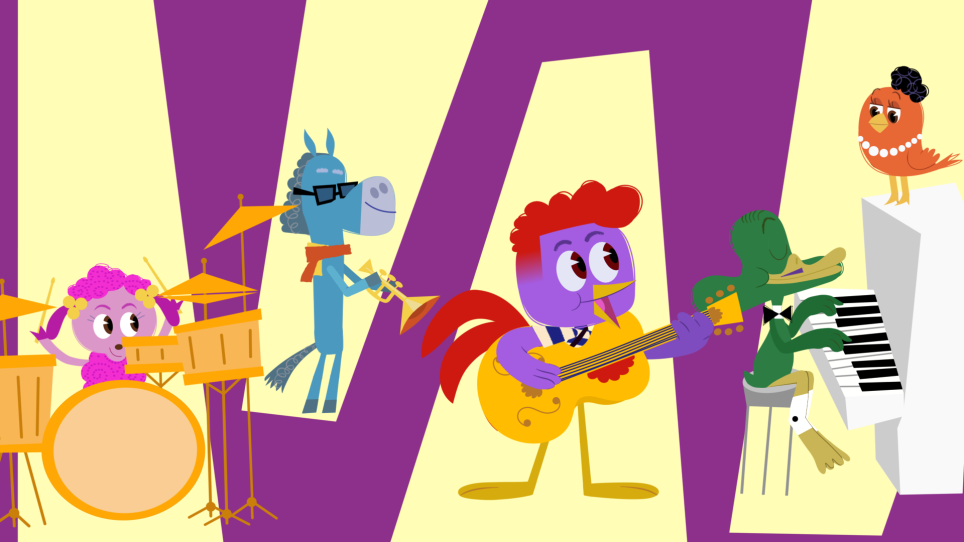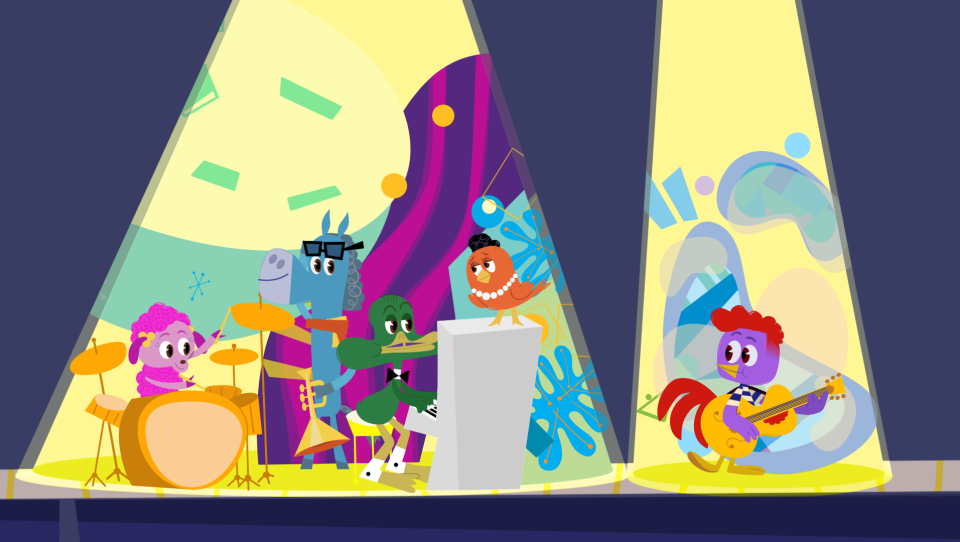Kwame Alexander’s journey with Acoustic Rooster, GBH Kids’ new animated special and short-form digital series based on his children’s book, began more than 15 years ago on a Tuscan hillside. Whisked away to Italy for a writing fellowship and struggling to put pen to paper, Alexander went for long walks where he encountered chickens, pigs, and other livestock on a neighboring farm.
“After a couple of mornings of seeing them running around or playing,” says Alexander, “I thought, what if they’re having a party? And if they’re having a party, what music are they listening to? Jazz.”
“My imagination took over, and within an hour or so, I’d finished an early draft of Acoustic Rooster and His Barnyard Band.” A decade and a half later, seeing the characters brought to life in the new special and 20 accompanying Jazzy Jams (3 minute-long musical digital shorts) “feels like coming full circle,” he says.
Not unlike jazz, there’s an undeniable quality to Acoustic Rooster. From the vibrant art style and the cleverly named characters (e.g., “Mules Davis” and “Ella Finchgerald”), to the outstanding and imaginative music – complete with guest features from renowned musicians like Herbie Hancock and Amy Shook – the one-hour special leaps off the screen with an unbridled joy.
While bright colors and catchy tunes are nothing new to children’s programming, the brilliance of Acoustic Rooster lies in its use of jazz as a medium for communicating a whole host of ideas: American history, collaboration, humility – you name it, Rooster and his Barnyard Band likely sing about it.
We sat down with Kwame Alexander and GBH Kids Executive Producer Julius Harper to talk about the process of putting this special and short digital video series together, their hopes for connecting with audiences, and more.

When did your love for jazz begin?
KA: I discovered a crate of jazz records in my father’s attic during a spring break visit from college. I had never really listened to jazz, but I had recently purchased a used record player, so I borrowed those records to play on it. From there, I just fell in love with Nancy Wilson and Miles Davis and Frank Sinatra.
What have you been reading or listening to lately?
KA: My literary mother and mentor, Nikki Giovanni, passed away in December. I was in her office a couple days after, and I discovered two of her iPod Shuffles. So I figured out how to charge and listen to them. I’ve been listening to her playlist as a way to remember her.
She loved Bonnie Raitt; I’ve been listening to Bonnie Raitt, to Bill Evans’ Waltz for Debby, Peabo Bryson. It’s been making me smile, and it’s been helpful during this grieving process.
One of the ways your love for jazz manifests in the special is the character names referencing iconic jazz artists, like Duck Ellington. How did you come around to that idea?
KA: When I started writing the book, I knew the main character was going to be a rooster. From there, I tried adopting a rhyming pattern for the other characters’ names, but they never quite landed. So then I thought, ‘let me try to see if I can pay homage to the jazz legends.’
What’s it been like seeing this story and these characters you’ve lived with for 15+ years make the transition from a book, to a stage play, and now, a PBS special?
KA: When I first envisioned Acoustic Rooster, it was a living thing, so this is like coming full circle. I was always trying to figure out how to make these words and feelings jump off the page, and it’s been really exciting to see it happen.
What are the fruits of introducing children to jazz music?
KA: Aside from the fact that it’s such beautiful, uplifting music that makes you feel good, it’s truly American music. It gives kids the opportunity to learn more about their country and the creativity that’s shaped it.
This idea of democracy is at the heart of jazz, and I think that’s something that kids can learn from these musicians in Acoustic Rooster – how they collaborate to create beautiful music, but more importantly, become friends and change their world.
JH: Jazz is really all about improvisation and collaboration, which are so foundational for young kids learning how to be in the world. They’re learning about how to express themselves artistically, in social situations, and they’re learning how to get along with others. You need to know when it’s time to step forward and do your solo, when it’s time to let someone else take the spotlight, or support them in call and response. Being able to explore that through the lens of jazz is something that makes this show really stand apart.
What surprised you in the process of developing the special and digital shorts?
JH: There were three pillars that really gave us confidence in the making of this project.
First was how much young kids were connecting with the music. The challenge for Acoustic Rooster was to make jazz, a storied art form that stretches back nearly a hundred years, relevant to three- and four-year-olds. That’s no small feat. We found that connection in Mark McLean, our composer for the project. He’s a Juno award-winning jazz artist who lives and breathes this world. He was very quickly able to identify how we take this historical music and make it as fun, danceable, and engaging as possible.
I knew we’d hit the mark when we screened the first song from the special for a group of kids. Seeing little kids dancing together – not being asked or instructed – just spontaneously connecting with the music they were hearing, was kind of profound and moving to witness. It still makes my hair stand up when I think about it. I was really grateful to see that – it was like, ‘All right, we landed the plane. The kids are here and they’re enjoying it.’
Another discovery we made was our lead, Dom [Dominic Bell], who plays Rooster. We did an extended casting search and auditioned so many kids, then one day Dom stepped into the booth. From the moment he opened his mouth, we knew we had found him. He has this perfect combination of adorableness, cheekiness, and vulnerability that we were looking for in Rooster.
And then the third thing was the visual design. A lot of the folks working on the show turned out to be jazz fans in their own right, so working with Bruce Alcock at our animation studio, Global Mechanic, we landed on a visual aesthetic that was super unique and striking because it was informed by the artistic movements of mid-century jazz, and used famous albums’ cover art as touchpoints. I think that really unlocked a lot of passion on the part of our art directors and character designers.
Why was it important for you to partner with GBH and PBS to adapt Acoustic Rooster and make it free and widely available to the public?
KA: Growing up in Chesapeake, Virginia, PBS was on Channel 15. We couldn’t watch a whole lot of TV, but PBS was always there for us. For kids to continue to have that opportunity is valuable, critical, and crucial. I’m in my 50s, and I’m still talking about programs that I watched 50 years ago that are meaningful and significant to me.
For some reason, our politicians have forgotten the stories their mothers read to them at bedtime, they’ve forgotten the shows they watched on Saturday morning – how much they laughed and learned from them. They’ve forgotten the value of civic engagement, trust, and fun that these shows bring to kids.
If they hadn’t, they wouldn’t be challenging the future of public media, they wouldn’t be considering taking away the funding for public media. These things are invaluable; they mean everything. They are at the heart of American progress, and I’m an example of that.
I’m glad to be in that tradition of creating content that’s both educational and entertaining. PBS Kids was the best place for this, and I’m excited to see what we do together.
Share the joys of jazz with your friends and family with the Acoustic Rooster PBS special, Acoustic Rooster: Jazzy Jams digital shorts, and the video game, Groovin’ with Acoustic Rooster!





